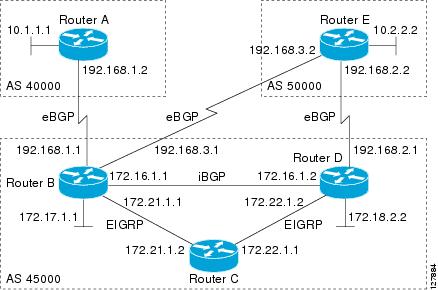| Step 1 |
enable
|
Enables privileged EXEC mode.
|
| Step 2 |
configure
terminal
DeviceB# configure terminal
|
Enters global configuration mode.
|
| Step 3 |
router
bgp
autonomous-system-number
DeviceB(config)# router bgp 45000
|
Enters router configuration mode for the specified routing process.
|
| Step 4 |
bgp
log-neighbor-changes
DeviceB(config-router)# bgp log-neighbor-changes
|
(Optional) Enables logging of BGP neighbor status changes (up or down) and neighbor resets.
|
| Step 5 |
neighbor
peer-group-name
peer-group
DeviceB(config-router)# neighbor group192 peer-group
|
Creates a BGP peer group.
|
| Step 6 |
bgp
listen
[limit
max-number ]
DeviceB(config-router)# bgp listen limit 200
|
Sets a global limit of BGP dynamic subnet range neighbors.
| Note
|
Only the syntax applicable to this task is used in this example. For the complete syntax, see Step 7.
|
|
| Step 7 |
bgp
listen
[limit
max-number |
range
network
/
length
peer-group
peer-group-name ]
DeviceB(config-router)# bgp listen range 192.168.0.0/16 peer-group group192
|
Associates a subnet range with a BGP peer group and activates the BGP dynamic neighbors feature.
-
Use the optional
limit keyword and
max-number argument to define the maximum number of BGP dynamic neighbors that can be created.
-
Use the optional
range keyword and
network
/
length argument to define a prefix range to be associated with the specified peer group.
-
In this example, the prefix range 192.168.0.0/16 is associated with the listen range group named group192.
|
| Step 8 |
neighbor
{ip-address
|
ipv6-address
|
peer-group-name }
ebgp-multihop
[ ttl ]
DeviceB(config-router)# neighbor group192 ebgp-multihop 255
|
Accepts and attempts BGP connections to external peers residing on networks that are not directly connected.
|
| Step 9 |
neighbor
peer-group-name
remote-as
autonomous-system-number
[alternate-as
autonomous-system-number... ]
DeviceB(config-router)# neighbor group192 remote-as 40000 alternate-as 50000
|
Adds the IP address or peer group name of the neighbor in the specified autonomous system to the IPv4 multiprotocol BGP neighbor
table of the local router.
-
Use the optional
alternate-as keyword and
autonomous-system-number argument to identify up to five alternate autonomous system numbers for listen range neighbors.
-
In this example, the peer group named group192 is configured with two possible autonomous system numbers.
| Note
|
The
alternate-as keyword is used only with the listen range peer groups, not with individual BGP neighbors.
|
|
| Step 10 |
address-family
ipv4
[mdt |
multicast |
unicast [vrf
vrf-name ]]
DeviceB(config-router)# address-family ipv4 unicast
|
Enters address family configuration mode to configure BGP peers to accept address-family-specific configurations.
|
| Step 11 |
neighbor
{ip-address |
peer-group-name }
activate
DeviceB(config-router-af)# neighbor group192 activate
|
Activates the neighbor or listen range peer group for the configured address family.
| Note
|
Usually BGP peer groups cannot be activated using this command, but the listen range peer groups are a special case.
|
|
| Step 12 |
end
DeviceB(config-router-af)# end
|
Exits address family configuration mode and returns to privileged EXEC mode.
|
| Step 13 |
Move to another router that has an interface within the subnet range for the BGP peer group configured in this task.
|
|
| Step 14 |
enable
|
Enables privileged EXEC mode.
|
| Step 15 |
configure
terminal
DeviceE# configure terminal
|
Enters global configuration mode.
|
| Step 16 |
router
bgp
autonomous-system-number
DeviceE(config)# router bgp 50000
|
Enters router configuration mode for the specified routing process.
|
| Step 17 |
neighbor
{ip-address |
peer-group-name }
remote-as
autonomous-system-number [alternate-as
autonomous-system-number... ]
DeviceE(config-router)# neighbor 192.168.3.1 remote-as 45000
|
Adds the IP address or peer group name of the neighbor in the specified autonomous system to the IPv4 multiprotocol BGP neighbor
table of the local router.
-
In this example, the interface (192.168.3.2 in the figure above) at Router E is with the subnet range set for the BGP listen
range group, group192. When TCP opens a session to peer to Router B, Router B creates this peer dynamically.
|
| Step 18 |
Return to the first router.
|
|
| Step 19 |
show
ip
bgp
summary
DeviceB# show ip bgp summary
|
(Optional) Displays the BGP path, prefix, and attribute information for all connections to BGP neighbors.
|
| Step 20 |
show
ip
bgp
peer-group
[peer-group-name ] [summary ]
DeviceB# show ip bgp peer-group group192
|
(Optional) Displays information about BGP peer groups.
|
| Step 21 |
show
ip
bgp
neighbors
[ip-address ]
DeviceB# show ip bgp neighbors 192.168.3.2
|
(Optional) Displays information about BGP and TCP connections to neighbors.
| Note
|
Only the syntax applicable to this task is used in this example. For more details, see the
Cisco IOS IP Routing: BGP Command Reference.
|
|


 Feedback
Feedback